lock Hyundai Elantra 2017 Owner's Manual
[x] Cancel search | Manufacturer: HYUNDAI, Model Year: 2017, Model line: Elantra, Model: Hyundai Elantra 2017Pages: 637, PDF Size: 15.02 MB
Page 8 of 637

F8
Introduction
Use of MTBE
HYUNDAI recommends avoiding
fuels containing MTBE (Methyl
Tertiary Butyl Ether) over 15.0% vol.
(Oxygen Content 2.7% weight) in
your vehicle.
Fuel containing MTBE over 15.0%
vol. (Oxygen Content 2.7% weight)
may reduce vehicle performance and
produce vapor lock or hard starting.
Do not use methanol
Fuels containing methanol (wood
alcohol) should not be used in your
vehicle.This type of fuel can reduce
vehicle performance and damage
components of the fuel system, engine
control system and emission control
system.
Fuel Additives
HYUNDAI recommends that you use
unleaded gasoline which has an
octane rating of RON (Research
Octane Number) 95 / AKI (Anti Knock
Index) 91 or higher (for Europe) or
Octane Rating of RON (Research
Octane Number) 91 / AKI (Anti-Knock
Index) 87 or higher (except Europe).
For customers who do not use good
quality gasolines including fuel addi-
tives regularly, and have problems
starting or the engine does not run
smoothly, one bottle of additives added
to the fuel tank at every 15,000km (for
Europe)/ 5,000km (except Europe).
Additives are available from your
authorized HYUNDAI dealer along
with information on how to use them.
Do not mix other additives.
Operation in foreign countries
If you are going to drive your vehicle
in another country, be sure to:
Observe all regulations regarding
registration and insurance.
Determine that acceptable fuel is
available.
Your New Vehicle Limited
Warranty may not cover dam-
age to the fuel system and any
performance problems that are
caused by the use of fuels con-
taining methanol or fuels con-
taining MTBE (Methyl Tertiary
Butyl Ether) over 15.0% vol.
(Oxygen Content 2.7% weight.)
CAUTION
Page 13 of 637
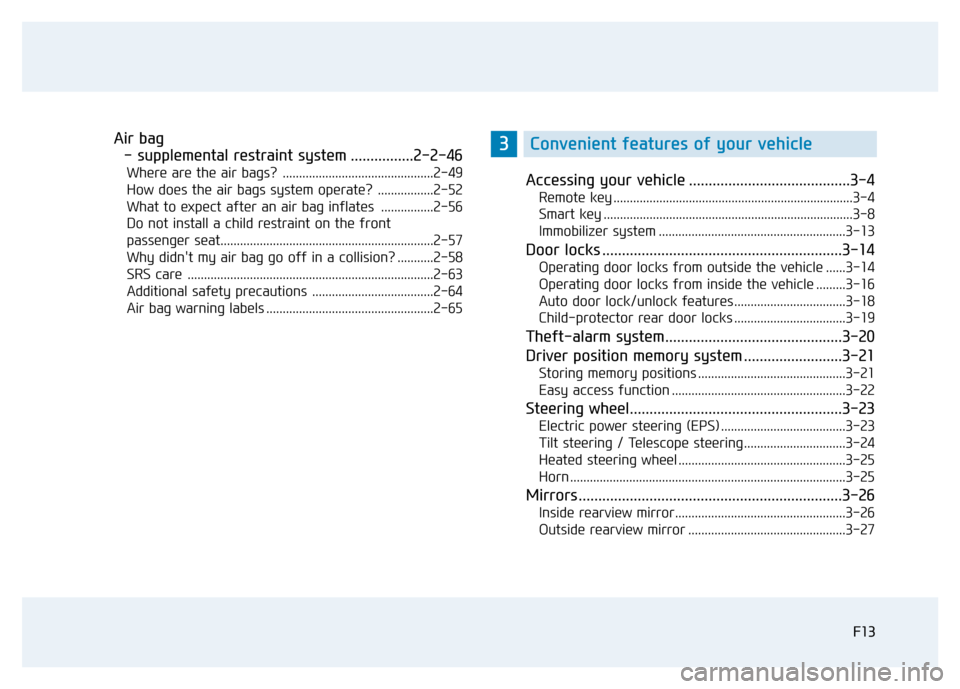
F13F13
Air bag
- supplemental restraint system ................2-2-46
Where are the air bags? ..............................................2-49
How does the air bags system operate? .................2-52
What to expect after an air bag inflates ................2-56
Do not install a child restraint on the front
passenger seat.................................................................2-57
Why didn't my air bag go off in a collision? ...........2-58
SRS care ...........................................................................2-63
Additional safety precautions .....................................2-64
Air bag warning labels ...................................................2-65Accessing your vehicle .........................................3-4
Remote key .........................................................................3-4
Smart key ............................................................................3-8
Immobilizer system .........................................................3-13
Door locks .............................................................3-14
Operating door locks from outside the vehicle ......3-14
Operating door locks from inside the vehicle .........3-16
Auto door lock/unlock features..................................3-18
Child-protector rear door locks ..................................3-19
Theft-alarm system.............................................3-20
Driver position memory system .........................3-21
Storing memory positions .............................................3-21
Easy access function .....................................................3-22
Steering wheel......................................................3-23
Electric power steering (EPS) ......................................3-23
Tilt steering / Telescope steering...............................3-24
Heated steering wheel ...................................................3-25
Horn ....................................................................................3-25
Mirrors ...................................................................3-26
Inside rearview mirror....................................................3-26
Outside rearview mirror ................................................3-27
3Convenient features of your vehicle
Page 15 of 637
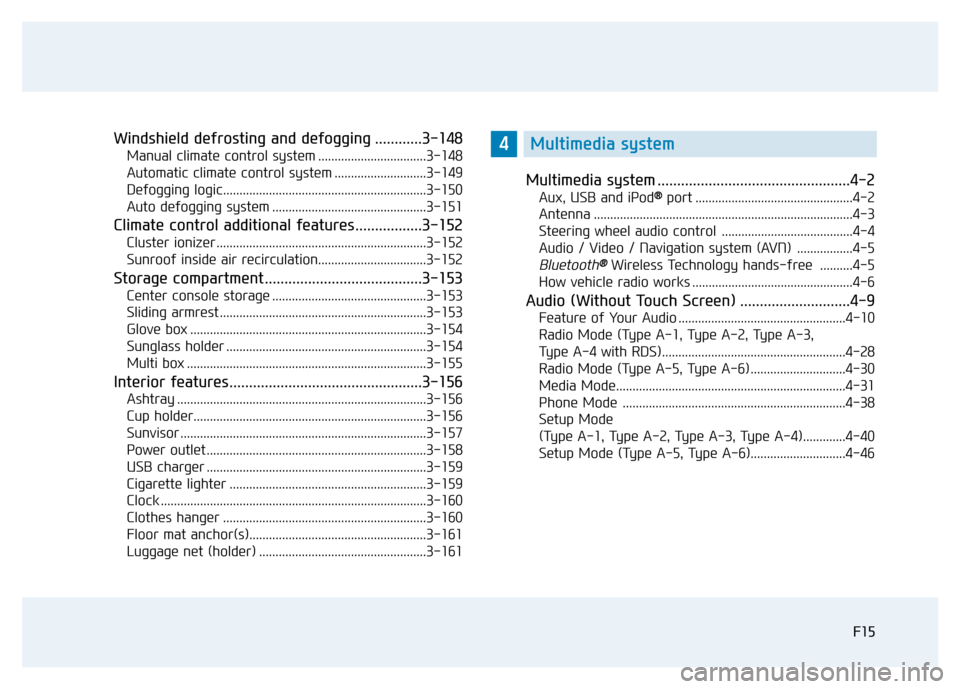
F15F15
Windshield defrosting and defogging ............3-148
Manual climate control system .................................3-148
Automatic climate control system ............................3-149
Defogging logic..............................................................3-150
Auto defogging system ...............................................3-151
Climate control additional features.................3-152
Cluster ionizer ................................................................3-152
Sunroof inside air recirculation.................................3-152
Storage compartment ........................................3-153
Center console storage ...............................................3-153
Sliding armrest ...............................................................3-153
Glove box ........................................................................3-154
Sunglass holder .............................................................3-154
Multi box .........................................................................3-155
Interior features.................................................3-156
Ashtray ............................................................................3-156
Cup holder.......................................................................3-156
Sunvisor ...........................................................................3-157
Power outlet ...................................................................3-158
USB charger ...................................................................3-159
Cigarette lighter ............................................................3-159
Clock .................................................................................3-160
Clothes hanger ..............................................................3-160
Floor mat anchor(s)......................................................3-161
Luggage net (holder) ...................................................3-161
Multimedia system .................................................4-2
Aux, USB and iPod® ®port ................................................4-2
Antenna ...............................................................................4-3
Steering wheel audio control ........................................4-4
Audio / Video / Navigation system (AVN) .................4-5
Bluetooth® ®Wireless Technology hands-free ..........4-5
How vehicle radio works .................................................4-6
Audio (Without Touch Screen) ............................4-9
Feature of Your Audio ...................................................4-10
Radio Mode (Type A-1, Type A-2, Type A-3,
Type A-4 with RDS)........................................................4-28
Radio Mode (Type A-5, Type A-6) .............................4-30
Media Mode......................................................................4-31
Phone Mode ....................................................................4-38
Setup Mode
(Type A-1, Type A-2, Type A-3, Type A-4).............4-40
Setup Mode (Type A-5, Type A-6).............................4-46
4Multimedia system
Page 17 of 637

F17F17
Braking system.....................................................5-41
Power brakes ...................................................................5-41
Disc brakes wear indicator ...........................................5-42
Rear drum brakes ...........................................................5-42
Parking brake ...................................................................5-42
Anti-lock Brake System (ABS) ....................................5-45
Electronic Stability Control (ESC)................................5-47
Vehicle Stability Management (VSM).........................5-50
Hill-start Assist Control (HAC) .....................................5-52
Emergency Stop Signal (ESS) ......................................5-52
Good braking practices..................................................5-53
ISG (Idle Stop and Go) system ...........................5-54
To activate the ISG system ...........................................5-54
To deactivate the ISG system ......................................5-57
ISG system malfunction .................................................5-57
The battery sensor deactivation .................................5-59
Drive mode integrated control system .............5-60
Blind Spot Detection system (BSD) ..................5-62
BSD (Blind Spot Detection) /
LCA (Lane Change Assist) .............................................5-63
RCTA (Rear Cross Traffic Alert) ..................................5-66
Limitations of the system .............................................5-69
Cruise control .......................................................5-71
Cruise Control operation ...............................................5-71
Special driving conditions ...................................5-78
Hazardous driving conditions.......................................5-78
Rocking the vehicle ........................................................5-78
Smooth cornering ...........................................................5-79
Driving at night ................................................................5-79
Driving in the rain ...........................................................5-79
Driving in flooded areas ................................................5-80
Highway driving ...............................................................5-80
Winter driving .......................................................5-81
Snow or icy conditions ..................................................5-81
Winter Precautions .........................................................5-83
Trailer towing .......................................................5-86
If you decide to pull a trailer .......................................5-87
Trailer towing equipment ..............................................5-91
Driving with a trailer ......................................................5-92
Maintenance when towing a trailer ...........................5-96
Vehicle weight ......................................................5-97
Overloading.......................................................................5-97
Page 25 of 637
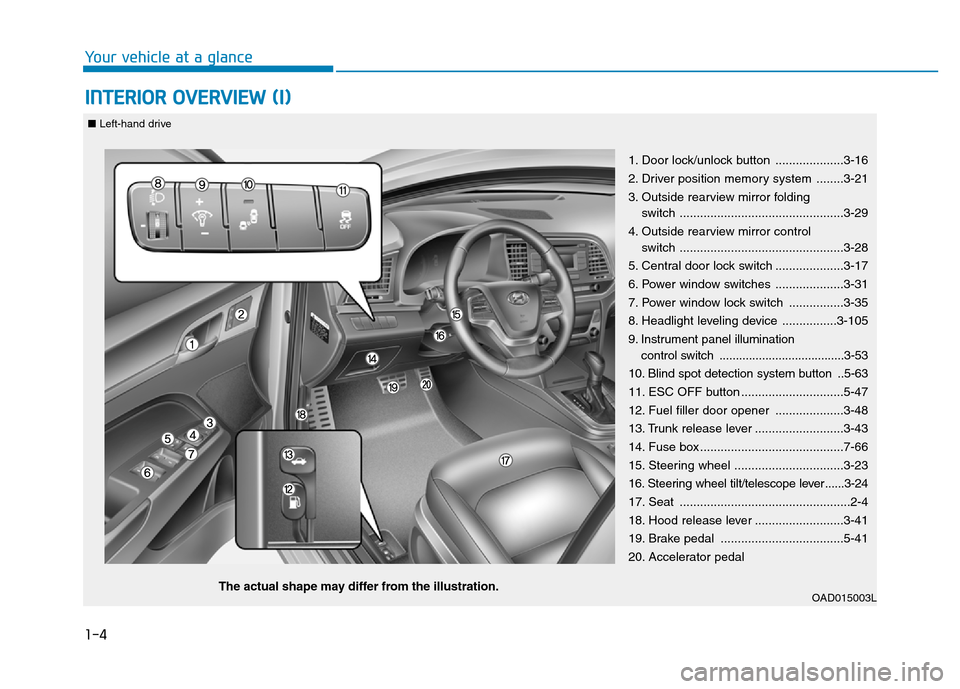
1-4
Your vehicle at a glance
INTERIOR OVERVIEW (I)
1. Door lock/unlock button ....................3-16
2. Driver position memory system ........3-21
3. Outside rearview mirror folding
switch ................................................3-29
4. Outside rearview mirror control
switch ................................................3-28
5. Central door lock switch ....................3-17
6. Power window switches ....................3-31
7. Power window lock switch ................3-35
8. Headlight leveling device ................3-105
9. Instrument panel illumination
control switch ......................................3-53
10. Blind spot detection system button ..5-63
11. ESC OFF button ..............................5-47
12. Fuel filler door opener ....................3-48
13. Trunk release lever ..........................3-43
14. Fuse box ..........................................7-66
15. Steering wheel ................................3-23
16. Steering wheel tilt/telescope lever ......3-24
17. Seat ..................................................2-4
18. Hood release lever ..........................3-41
19. Brake pedal ....................................5-41
20. Accelerator pedal
OAD015003LThe actual shape may differ from the illustration.
■Left-hand drive
Page 26 of 637

1-5
Your vehicle at a glance
INTERIOR OVERVIEW (II)
1
1. Door lock/unlock button ....................3-16
2. Driver position memory system ........3-21
3. Outside rearview mirror folding
switch ................................................3-29
4. Outside rearview mirror control
switch ................................................3-28
5. Central door lock switch ....................3-17
6. Power window switches ....................3-31
7. Power window lock switch ................3-35
8. Headlight leveling device ................3-105
9. Instrument panel illumination
control switch ......................................3-53
10. Blind spot detection system button ..5-63
11. ESC OFF button ..............................5-47
12. Fuel filler door opener ....................3-48
13. Trunk release lever ..........................3-43
14. Fuse box ..........................................7-66
15. Steering wheel ................................3-23
16. Steering wheel tilt/telescope lever ......3-24
17. Seat ..................................................2-4
18. Hood release lever ..........................3-41
19. Brake pedal ....................................5-41
20. Accelerator pedal
OAD015003RE
■ Right-hand drive
The actual shape may differ from the illustration.
Page 35 of 637
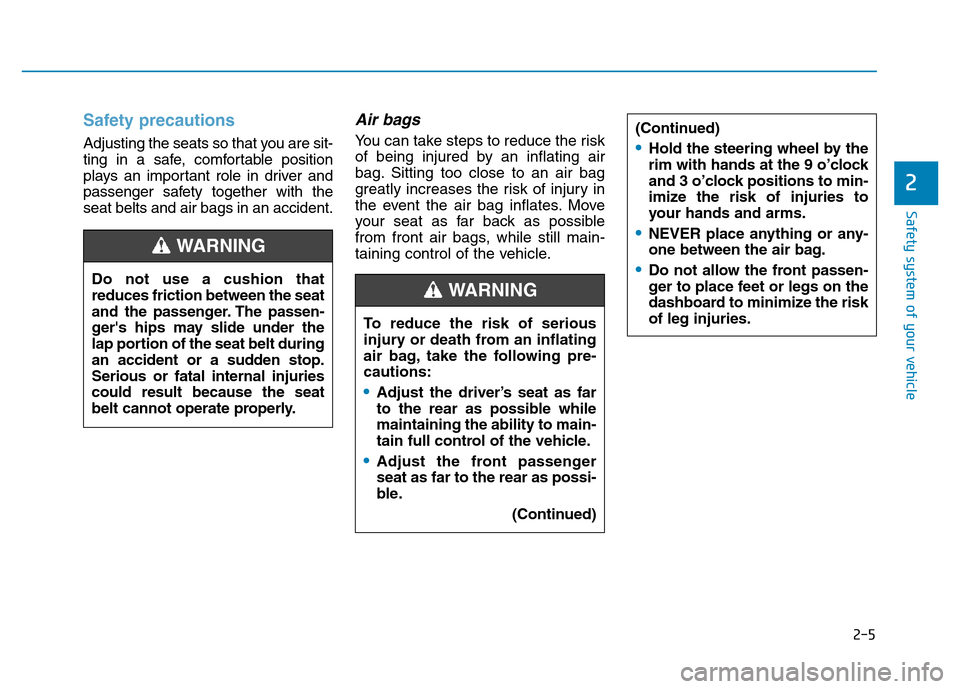
2-5
Safety system of your vehicle
2
Safety precautions
Adjusting the seats so that you are sit-
ting in a safe, comfortable position
plays an important role in driver and
passenger safety together with the
seat belts and air bags in an accident.
Air bags
You can take steps to reduce the risk
of being injured by an inflating air
bag. Sitting too close to an air bag
greatly increases the risk of injury in
the event the air bag inflates. Move
your seat as far back as possible
from front air bags, while still main-
taining control of the vehicle.
Do not use a cushion that
reduces friction between the seat
and the passenger. The passen-
ger's hips may slide under the
lap portion of the seat belt during
an accident or a sudden stop.
Serious or fatal internal injuries
could result because the seat
belt cannot operate properly.
WARNING
To reduce the risk of serious
injury or death from an inflating
air bag, take the following pre-
cautions:
•Adjust the driver’s seat as far
to the rear as possible while
maintaining the ability to main-
tain full control of the vehicle.
•Adjust the front passenger
seat as far to the rear as possi-
ble.
(Continued)
WARNING
(Continued)
•Hold the steering wheel by the
rim with hands at the 9 o’clock
and 3 o’clock positions to min-
imize the risk of injuries to
your hands and arms.
•NEVER place anything or any-
one between the air bag.
•Do not allow the front passen-
ger to place feet or legs on the
dashboard to minimize the risk
of leg injuries.
Page 37 of 637

2-7
Safety system of your vehicle
Manual adjustment
Forward and rearward adjustment
To move the seat forward or rearward:
1. Pull up the seat slide adjustment
lever and hold it.
2. Slide the seat to the position you
desire.
3. Release the lever and make sure
the seat is locked in place. Move
forward and rearward without using
the lever. If the seat moves, it is not
locked properly.
2
To prevent injury:
•Do not adjust your seat while
wearing your seat belt.
Moving the seat cushion for-
ward may cause strong pres-
sure on your abdomen.
•Do not allow your hands or
fingers to get caught in the
seat mechanisms while the
seat is moving.
CAUTION(Continued)
•Do not allow anything to inter-
fere with the normal position
and proper locking of the seat-
back.
•Do not place a cigarette lighter
on the floor or seat. When you
operate the seat, gas may exit
out of the lighter causing a fire.
•Use extreme caution when
picking small objects trapped
under the seats or between
the seat and the center con-
sole. Your hands might be cut
or injured by the sharp edges
of the seat mechanism.
•If there are occupants in the
rear seats, be careful while
adjusting the front seat posi-
tion.
OAD035002
Page 38 of 637

2-8
Seatback angle
To recline the seatback:
1. Lean forward slightly and lift up the
seatback lever.
2. Carefully lean back on the seat
and adjust the seatback to the
position you desire.
3. Release the lever and make sure
the seatback is locked in place.
(The lever MUST return to its orig-
inal position for the seatback to
lock.)Reclining seatback
Sitting in a reclined position when
the vehicle is in motion can be dan-
gerous. Even when buckled up, the
protections of your restraint system
(seat belts and/or air bags) is greatly
reduced by reclining your seatback.Seat belts must be snug against your
hips and chest to work properly.
When the seatback is reclined, the
shoulder belt cannot do its job
because it will not be snug against
your chest. Instead, it will be in front
of you. During an accident, you could
be thrown into the seat belt, causing
neck or other injuries.
The more the seatback is reclined,
the greater chance the passenger’s
hips will slide under the lap belt or
the passenger’s neck will strike the
shoulder belt.
Safety system of your vehicle
OAD035003NEVER ride with a reclined
seatback when the vehicle is
moving.
Riding with a reclined seatback
increases your chance of seri-
ous or fatal injuries in the event
of a collision or sudden stop.
Drivers and passengers should
ALWAYS sit well back in their
seats, properly belted, and with
the seatbacks upright.
WARNING
Page 43 of 637
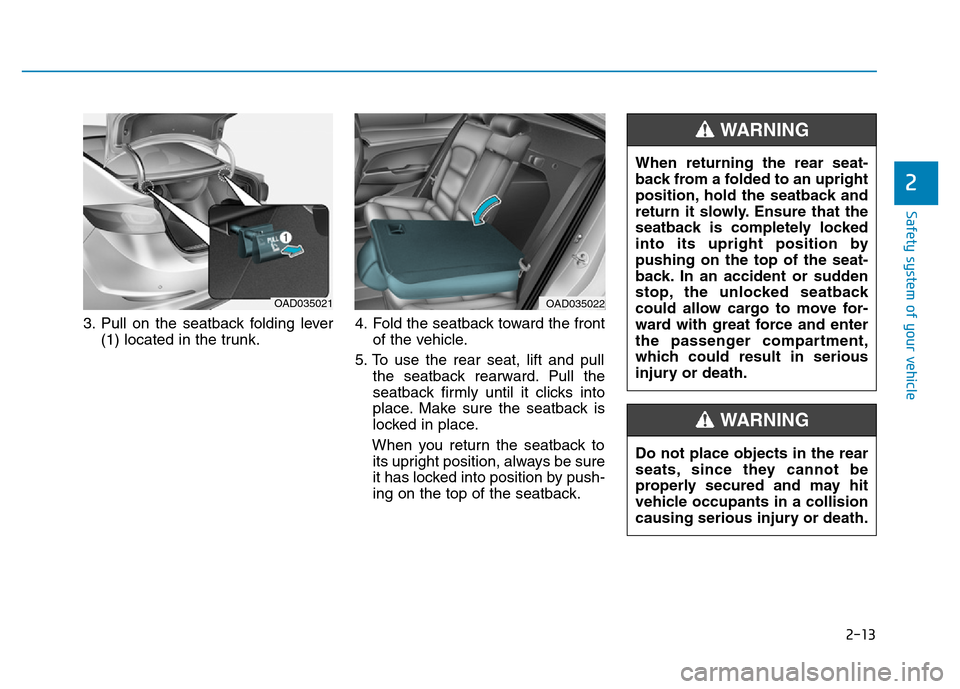
2-13
Safety system of your vehicle
3. Pull on the seatback folding lever
(1) located in the trunk.4. Fold the seatback toward the front
of the vehicle.
5. To use the rear seat, lift and pull
the seatback rearward. Pull the
seatback firmly until it clicks into
place. Make sure the seatback is
locked in place.
When you return the seatback to
its upright position, always be sure
it has locked into position by push-
ing on the top of the seatback.
2
OAD035021OAD035022
Do not place objects in the rear
seats, since they cannot be
properly secured and may hit
vehicle occupants in a collision
causing serious injury or death.
WARNING
When returning the rear seat-
back from a folded to an upright
position, hold the seatback and
return it slowly. Ensure that the
seatback is completely locked
into its upright position by
pushing on the top of the seat-
back. In an accident or sudden
stop, the unlocked seatback
could allow cargo to move for-
ward with great force and enter
the passenger compartment,
which could result in serious
injury or death.
WARNING